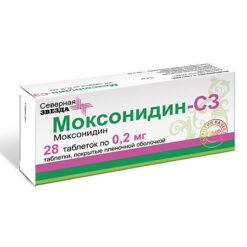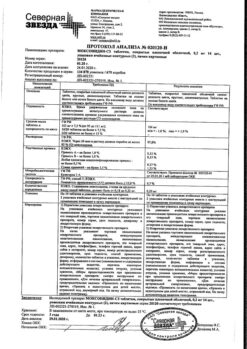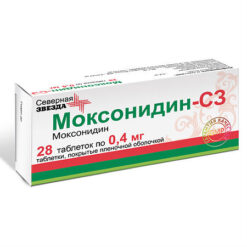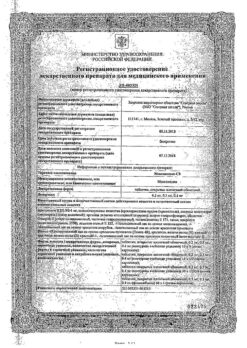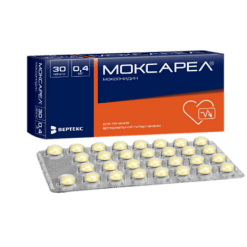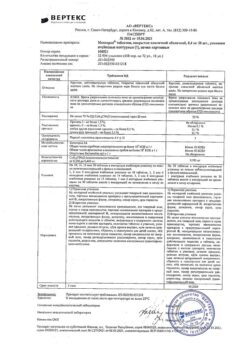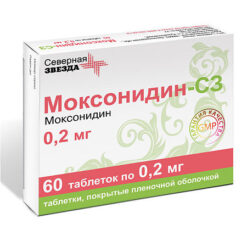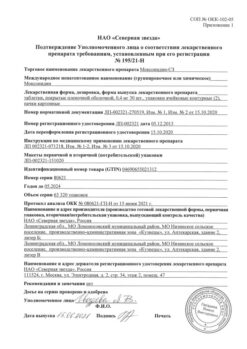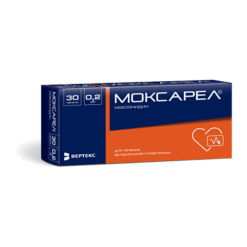No products in the cart.
Moxonidine-SZ, 0.4 mg 30 pcs
€7.33 €6.41
Description
An antihypertensive drug with a central mechanism of action.
In brain stem structures (rostral layer of lateral ventricles) moxonidine selectively stimulates imidazoline-sensitive receptors participating in tonic and reflex regulation of sympathetic nervous system.
Stimulation of imidazoline receptors reduces peripheral sympathetic activity and BP.
Moxonidine differs from other sympatholytic antihypertensive agents in its lower affinity for α2-adrenoreceptors, which explains the lower likelihood of developing sedation and dry mouth.
The use of moxonidine leads to a decrease in ROS and BP.
Moxonidine improves insulin sensitivity index by 21% (compared to placebo) in patients with obesity, insulin resistance and moderate arterial hypertension.
Indications
Indications
Arterial hypertension.
Pharmacological effect
Pharmacological effect
Antihypertensive drug with a central mechanism of action.
In the brain stem structures (rostral layer of the lateral ventricles), moxonidine selectively stimulates imidazoline-sensitive receptors that take part in the tonic and reflex regulation of the sympathetic nervous system.
Stimulation of imidazoline receptors reduces peripheral sympathetic activity and blood pressure.
Moxonidine differs from other sympatholytic antihypertensive drugs in its lower affinity for α2-adrenergic receptors, which explains the lower likelihood of developing sedation and dry mouth.
The use of moxonidine leads to a decrease in peripheral vascular resistance and blood pressure.
Moxonidine improves the insulin sensitivity index by 21% (compared to placebo) in patients with obesity, insulin resistance and moderate hypertension.
Special instructions
Special instructions
If it is necessary to cancel simultaneously taken beta-blockers and the drug Moxonidine-SZ, first cancel the beta-blockers and only after a few days Moxonidine-SZ. There is currently no evidence that discontinuation of Moxonidine-SZ leads to an increase in blood pressure. However, it is not recommended to stop taking Moxonidine-SZ suddenly; instead, you should gradually reduce the dose of the drug over 2 weeks.
During treatment, alcohol consumption should be avoided.
During treatment, regular monitoring of heart rate and ECG is necessary.
Impact on the ability to drive vehicles and operate machinery
The effect of Moxonidine-SZ on the ability to drive vehicles or operate machinery has not been studied.
However, taking into account the possibility of dizziness and drowsiness, patients should be careful when driving vehicles and engaging in other activities that require increased concentration.
Active ingredient
Active ingredient
Moxonidine
Composition
Composition
1 tab. – moxonidine 0.4 mg.
Pregnancy
Pregnancy
There are no clinical data on the use of Moxonidine in pregnant women.
Contraindications
Contraindications
– severe renal failure (creatinine clearance less than 30 ml/min);
– severe heart rhythm disturbances;
— SSSU;
— severe bradycardia (resting heart rate less than 50 beats/min);
– AV block of II and III degrees;
— acute and chronic heart failure (III-IV functional class according to the NYHA classification);
– simultaneous use with tricyclic antidepressants;
– hemodialysis;
– lactation period;
— age over 75 years;
– age under 18 years (due to the lack of data on safety and effectiveness);
– hereditary lactose intolerance, lactase deficiency or glucose-galactose malabsorption;
– hypersensitivity to the active substance and other components of the drug.
With caution
Particular caution must be exercised when using moxonidine in patients with first degree AV block (risk of developing bradycardia); severe coronary artery disease, severe coronary artery disease or unstable angina (insufficient experience with use), chronic heart failure, severe liver failure, impaired renal function (creatinine clearance more than 30 ml/min).
Side Effects
Side Effects
The frequency of side effects listed below was determined according to the following: very often (>1/10); often (>1/100, 1/1000, <1/100); including individual messages.
From the side of the central nervous system: often – headache*, dizziness (vertigo), drowsiness; infrequently – fainting*.
Mental disorders: often – insomnia; infrequently – nervousness.
From the organ of hearing and labyrinthine disorders: infrequently – ringing in the ears.
From the cardiovascular system: infrequently – marked decrease in blood pressure, orthostatic hypotension*, bradycardia.
From the digestive system: very often – dryness of the oral mucosa; often – diarrhea, nausea, vomiting, dyspepsia.
From the skin and subcutaneous tissues: often – skin rash, itching.
From the musculoskeletal system: often – back pain; infrequently – pain in the neck.
Allergic reactions: infrequently – angioedema.
General disorders and disorders at the injection site: often – asthenia; infrequently – peripheral edema.
* – frequency comparable to placebo.
Interaction
Interaction
The combined use of moxonidine with other antihypertensive drugs leads to an additive effect.
Tricyclic antidepressants may reduce the effectiveness of centrally acting antihypertensive drugs, and therefore their simultaneous use with moxonidine is not recommended.
Moxonidine may enhance the effect of tricyclic antidepressants, tranquilizers, ethanol, sedatives and hypnotics. Moxonidine may moderately improve impaired cognitive function in patients receiving lorazepam.
Moxonidine may enhance the sedative effect of benzodiazepine derivatives when used simultaneously.
Moxonidine is released by tubular secretion, so its interaction with other drugs released by tubular secretion is possible.
Beta-blockers increase bradycardia and the severity of negative ino- and dromotropic effects.
Overdose
Overdose
There have been reports of several cases of non-fatal overdose when doses up to 19.6 mg were used simultaneously.
Symptoms: headache, sedation, excessive decrease in blood pressure, dizziness, asthenia, bradycardia, dry oral mucosa, vomiting, fatigue, epigastric pain, respiratory depression and impaired consciousness. In addition, short-term increases in blood pressure, tachycardia and hyperglycemia are also possible, as has been shown in several studies examining the use of the drug in high doses in animals.
Treatment: There is no specific antidote. In case of an excessive decrease in blood pressure, it may be necessary to restore bcc through the administration of fluid and dopamine (injection).
Storage conditions
Storage conditions
The drug should be stored out of the reach of children, in a dry, dark place at a temperature not exceeding 25°C.
Shelf life
Shelf life
3 years
Manufacturer
Manufacturer
North Star NAO, Russia
Additional information
| Shelf life | 3 years |
|---|---|
| Conditions of storage | The drug should be kept out of reach of children, dry and protected from light at a temperature not exceeding 25 ° C. |
| Manufacturer | North Star NAO, Russia |
| Medication form | pills |
| Brand | North Star NAO |
Other forms…
Related products
Buy Moxonidine-SZ, 0.4 mg 30 pcs with delivery to USA, UK, Europe and over 120 other countries.


